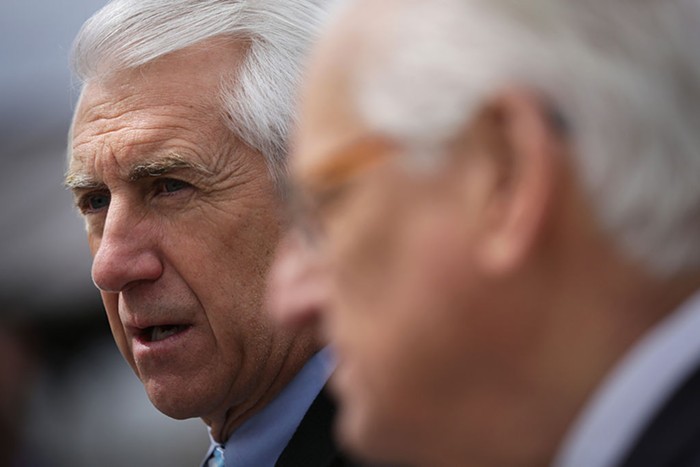The shaking, which clocked in at 7.2 on the Richter scale, began some 12 miles beneath the surface and continued for just 30 seconds. But the toll, both human and infrastructural, was immense: More than 6,500 lives, 50,000 buildings, and a major elevated expressway--the backbone connecting two large urban centers--were lost.
The earthquake took place in Kobe, Japan. The elevated highway was the Hanshin Expressway, a 40-kilometer-long viaduct that ran along the narrow corridor connecting two cities, Kobe and Osaka, on Japan's main island. But it could just as easily have been Seattle's Alaskan Way Viaduct, which, like the Hanshin, sits on a powder keg of unstable soils and colliding tectonic plates. Among other similarities, both Kobe and Seattle ride on the boundary between two plates and are pocked with dozens of shallow, earthquake-prone faults. According to University of Washington civil engineer Charles Roeder, such areas of colliding tectonic plates, known as subduction zones, "produce the largest earthquakes that have ever been recorded."
If the viaduct goes, it will happen something like this: As the ground begins to shake, the loose, watery soil underneath the viaduct will fail, putting pressure on the 70-year-old seawall that provides some of the structure's support. If the seawall collapses, it could take the viaduct's foundations down with it. University of Washington earthquake expert Steve Kramer says that in the "doomsday scenario"--a large, shallow earthquake along the Seattle Fault, which the viaduct traverses--"the viaduct collapses." It wouldn't even take a catastrophic quake. According to a study of the viaduct Kramer coauthored all the way back in 1995, "significant damage is likely even if the motion is considerably less intense, and hence more likely" to occur than a doomsday-level earthquake.
Kramer was proved right six years later, when the February 2001 Nisqually quake did millions of dollars in damage to the viaduct and shut the structure down for two consecutive days. Since then, we've spent nearly three years pondering what the demolition of the viaduct would mean for the "future of the waterfront." If the Big One does hit, people will die. Unfortunately, that may be what it takes to get people to stop talking--and start acting.
Linda Mullen, communications director for the Washington State Department of Transportation (WSDOT), takes the Alaskan Way Viaduct on her way to WSDOT's offices in Olympia every week. Like others at WSDOT, Mullen is all too aware of the viaduct's vulnerability. She says that if the viaduct collapses, it will most likely fall sideways, toppling into the row of three- and four-story buildings that line the east side of the structure. (In the 1989 Loma Prieta earthquake in San Francisco, in contrast, a portion of a double-deck elevated highway collapsed vertically, a phenomenon engineers euphemistically refer to as "pancaking.") The ordinarily understated Mullen acknowledges that, as a commuter, the doomsday scenario worries her. "It's safe so long as you can be off of it before the next quake starts," she says. "I just hope I'm not on it during that four-minute window."
Back in the 1950s, when the viaduct was built, Seattle had been settled for only 100 years--"a split second in geological time," Kramer says. No one anticipated the kind of earthquakes that shook the Puget Sound region in 1965 and 2001, much less the sort that rocked the area back in 1700, producing 33-foot-high tsunamis and leveling the Pacific Northwest coastline, which dropped between three and six feet from British Columbia to northern California. "People weren't aware of seismic issues" back in the '50s, Maureen Sullivan, WSDOT's viaduct project director, says. As a result, seismic standards when the viaduct was built were less than one-third as stringent as modern requirements.
Like the founders of other budding western metropolises, Seattle's early developers wanted people to move here. As a result, they may have preferred to hype the benefits of building up the waterfront--which was, before it was redeveloped, more swampy muck than walkable waterway--without acknowledging the earthquake risk that was an inevitable side effect of those developments. But whatever the case, the way the Alaskan Way Viaduct was built and the soils that underlie it make the elevated roadway a virtual laboratory for seismic catastrophe.
Underneath the viaduct, extending as far as 280 feet underground, is a layer of loose, watery soil, much of it pumped to Elliott Bay from the site of the Denny Regrade in the early 20th century. This mucky mixture of dirt and water is held in check by a timber-and-concrete seawall, built mostly in the 1930s and supported by steel pilings that extend through the fill to the sturdier soil below. Tests performed by WSDOT in 2003 revealed that nearly half of the relieving platform that extends behind the seawall had been significantly damaged; tiny marine crustaceans, known as gribbles, are nibbling away the platform bit by bit. The viaduct, likewise, is shored up with poorly supported pilings; its concrete columns, deck, and steel reinforcing bars are also insufficient by current earthquake standards. Any one of these weak points might threaten a structure like the viaduct. Taken together, they are literally a disaster waiting to happen.
Even in the absence of a major quake, the viaduct is hardly invulnerable to catastrophe. In fact, Kramer says, the viaduct is so deficient, "we could have an earthquake that could cause very severe problems for the viaduct without causing major damage elsewhere."
During the Nisqually quake, the viaduct's columns and decks were badly damaged--so much so that trucks and buses were restricted to the right lane in each direction. According to WSDOT's Mullen, it's only a matter of time before they're kicked off altogether.
In the meantime, WSDOT has taken several stopgap measures to slow the viaduct's deterioration. Standing under the viaduct on a recent bracing afternoon, Sullivan pointed out some of the fixes WSDOT has made to shore up the threatened structure. In the areas that sustained the most damage--along the central waterfront--columns have been reinforced with giant steel beams and carbon fiber. Where water has seeped into the concrete columns, causing the viaduct's reinforcing bars to rust, WSDOT workers have come along and knocked off the cracking concrete with hammers. Finally, cracks in the roadway decks have been filled in with epoxy--otherwise known as glue. The final bill for all these repairs, which span a distance of about one block: $3.5 million.
All that money hasn't stopped the viaduct from moving. In fact, according to Sullivan, the viaduct has continued to settle since 2001, causing expansion joints on the viaduct's deck to smash together. Whether the settling is due to earthquakes remains unclear. Meanwhile, according to a study done by a private firm in 2002, the viaduct's deck has drifted--moved sideways--between 1.5 and 3 inches. Ultimately, no matter what repairs are done, a 2001 WSDOT study concluded, the viaduct will have to be replaced. "We're trying to keep it going for now," Sullivan says. "But on the other hand, you don't want to spend millions and millions of dollars on a structure that's falling down."
Currently, the DOT is considering three types of alternatives for replacing the failing viaduct. The first, most expensive option--either of two versions of a $3.8-$4.1 billion "cut-and-cover tunnel" that would slice like a trench through the central waterfront--is supported by "livable city" advocates like Allied Arts of Seattle and City Council Member Peter Steinbrueck, who like it because it would put traffic underground, allowing redevelopment--parks, condos, and the like--to happen on the surface. The second option--either of two plans costing between $3.2 and $3.5 billion--would involve rebuilding the viaduct in place, preserving views (a favorite Seattle mantra) for commuters coming downtown from West Seattle; that option, though still officially under consideration, is the pariah of the bunch. The final (and cheapest) option--a $2.5-$2.8 billion six-lane surface-level boulevard that would partially replace the existing Alaskan Way--is supported by Seattle City Council transportation committee chair Richard Conlin, who sees it as the only affordable choice among the alternatives.
WSDOT has made no secret about its distaste for Conlin's preferred alternative. This fall, a WSDOT report predicted that the surface option would result in massive gridlock, nearly tripling travel times and crippling freight mobility. Conlin calls WSDOT's conclusion needlessly alarmist. "We're always talking about how wonderful Vancouver, BC, is. Well, they don't have a single freeway running through their downtown," Conlin says. "The traffic may be terrible, but it hasn't hurt their economy."
In fact, contrary to WSDOT's contention, the total gridlock politicians predicted in San Francisco when the elevated Embarcadero Freeway was demolished didn't materialize. Instead, traffic actually decreased. A California Department of Transportation study found that instead of sitting in traffic, people picked alternate routes, changed their commute times, and switched to public transportation. In other words, when faced with gridlock, people change their habits--which is, in the eyes of transit advocates, a good thing. Peter Hurley, director of the pro-transit Transportation Choices Coalition, says he finds the surface option "intriguing," although he has not endorsed any alternative. "I think it's significantly more doable than the [other] alternatives which are currently on the table," Hurley says.
Unfortunately, despite its handful of vocal advocates, the six-lane surface option remains a dark-horse opponent to the presumptive winner, the costly cut-and-cover tunnel. Talk of "linear promenades," "green space," and "unfulfilled commercial opportunities" along the waterfront have framed the viaduct debate, crowding out any discussion of concrete, infrastructure, and, most importantly, costs.
Although WSDOT has not taken a position on any of the viaduct alternatives, the agency's Urban Corridors Office administrator, David Dye, acknowledges that "a lot of people have expressed a preference for a tunnel." However, he says, "it will certainly be the most difficult alternative."
The need to replace the viaduct is clear. What's less obvious--what agencies like WSDOT are desperately scrambling to get a handle on--is how to pay for a project that will cost billions and take years, if not decades, to complete.
Every scenario for replacing the viaduct--from the cheapest, the surface roadway alternative, to the most expensive, the cut-and-cover tunnel--comes with a price tag in the billions. Complicating matters, a tax package that will provide most of the viaduct's initial funding has been bogged down by political wrangling, threatening to strangle the process in its infancy.
The viaduct isn't the only big-ticket priority on WSDOT's wish list. Interstate 405, the 520 bridge across Lake Washington, and State Route 509 are all in line for replacement or repairs, and each one comes with its own similarly daunting price tag. Taken together, WSDOT's list of top-priority projects for the upcoming decades will cost more than $20 billion.
Tying all these disparate projects together is an entity known as the Regional Transportation Investment District, or RTID (pronounced "ar-tid") for short. The RTID planning group, made up of the King, Pierce, and Snohomish county councils, is currently working on a list of projects (also referred to as "RTID") that it will ask voters to fund, with a combination of sales, license, and motor vehicle excise taxes, in 2004. Currently, King County's wish list for RTID includes $1 billion for the viaduct and another $1 billion for light rail--a controversial provision that some observers believe may backfire with voters, serving, in City Council Member Nick Licata's words, as an "anchor" that sinks the package.
RTID planners aren't leaving anything to chance. The failure of Referendum 51, a roads-heavy tax package that went down statewide last November, showed transportation planners the importance of picking an appealing project list. That's why King County Council Member Julia Patterson has commissioned a survey--to be done simultaneously by Democratic and Republican pollsters--to figure out what, exactly, voters are willing to support. The RTID planning group won't release its final project list until the spring of 2004. And RTID, which will likely include $1 billion for the viaduct, won't pay for even half of the least costly viaduct replacement plan. State, federal, and local money will have to fill the gap.
Already, the state legislature has pitched in, passing a controversial five-cent gas tax in April that will provide a relatively paltry $177 million for the viaduct. But some say it's not enough to make a dent in the region's costly list of transportation priorities. King County Council Member Dwight Pelz, who serves as chair of RTID's executive board, says that by failing to pay for the majority of the viaduct project, the legislature is trying to shirk its responsibility to fix a highway that benefits everyone in the state. "The legislature is saying, 'It's okay for it to fall down, and not only is it okay for people to die, but we have no intention of fixing it,'" Pelz says. "If we pay to build a state highway [in the RTID region] it will be an unprecedented act of local generosity. If WSDOT thinks we're going to pay a billion for the viaduct in RTID and they're not going to come up with the rest, they're crazy."
Still, it's impossible to overestimate the importance of RTID's passage for the viaduct. During a recent interview at WSDOT's offices in Pioneer Square, state secretary of transportation Doug MacDonald--a large, garrulous man who may be the most opinionated bureaucrat in WSDOT history--readily acknowledged that "the premium on RTID is huge," adding, "We don't have a plan, absent RTID, to fix the problems that need to be fixed." Without RTID, state house appropriations committee chair Helen Sommers notes, "there is simply not enough money" in local, state, and federal coffers to fix the viaduct--or anything else. Failure to pass RTID would be "disastrous," Sommers says.
The pressure to pass RTID is one reason WSDOT commissioned a costly ($70,000) series of focus groups to help determine what projects the voters consider worth funding. The result? Voters want roads, transit, bridges, and highway improvements. They also want lower license fees, but are willing to accept higher taxes if it will shorten their commutes. And, most importantly, they want it done right away. "Everyone wants it right now, just the way they particularly perceive it," MacDonald grouses.
But among all the focus groups, one thing was a constant: All the participants agreed that the viaduct was the region's number-one transportation priority. The main issue, according to the study: "safety concerns about the [viaduct's]... vulnerability to earthquakes."
"The earthquake connection grabs people," MacDonald says. "People said things like, 'We have a moral obligation to fix the viaduct.'"
Given that earthquake safety is voters' number one priority, you might think that the central waterfront--with its failing seawall, weak soils, extensive earthquake damage, and huge redevelopment potential--would be first in line for RTID funding. You'd be wrong. Planners, driven by a combination of political pressures and waterfront redevelopment schemes, are pushing to put off replacing the viaduct along the central waterfront until a second round of funding can be found. Under a plan supported by the King County Department of Transportation (KCDOT), the south end--the segment running from South King Street to South Holgate Street, where the soils are weakest but there is no seawall to compromise the viaduct's structural integrity--would snag the initial billion.
Why the seeming discrepancy between what observers say must be done and the proposal that's on the table? According to Licata, "development plans," not need, are driving the push to move construction southward. The Port of Seattle owns at least 20 acres of waterfront property along Pier 46, at the viaduct's southern end. Currently, that land is occupied by Hanjin Shipping, which has a lease on the property until 2010. But if Hanjin decides not to renew its lease--a decision is expected by the end of 2004--that prime waterfront real estate will be ripe for development. A new basketball arena and 10,000 units of housing are part of a proposed redevelopment linking Pioneer Square to the south end of the downtown waterfront. The viaduct fix, which includes connections to a new overpass south of Safeco Field, would be an integral part of any redevelopment, increasing access to the Port-owned property. "This is being [proposed] because of pressure by urban planners to clear the decks for developing this land," Licata says. "It's not nefarious, but let's recognize it for what it is."
Ron Posthuma, deputy director of KCDOT, acknowledges that fixing the viaduct's south end would benefit the Port and the stadiums. "You get independent utility out of the south end," he says. Port spokesman Mick Schultz would not discuss the redevelopment plans, noting that Hanjin has not yet decided whether it will stay or go.
The widespread preference for the costly tunnel option is another reason WSDOT won't commit to rebuilding the viaduct along the central waterfront first. The central part of the tunnel can't be built before the north and south ends are in place--unless, of course, WSDOT wants to build "part of a tunnel that goes nowhere," Dye says. But because the tunnel requires $3 billion more than RTID will provide, the state and city can't afford to do it all at once. "If you've 'only' got $1 billion and you've got a plan that costs $3.5 to $4 billion, you have to demonstrate to people that they're going to benefit from that," says Dye. (The seawall, which just received a small chunk of federal funding, is a separate, but related, headache; it will have to be replaced during viaduct construction, to avoid the hassle of two giant construction projects along the central waterfront.) Licata contends that because WSDOT has offered no evidence "that the south end is more likely to have a major malfunction than the central portion, [the central waterfront] is where our attention should be focused."
Licata's right, but he doesn't go far enough. Not only should we focus on the central waterfront, we should do it now--not in five years (when WSDOT estimates construction could begin), not after more process, discussions, and debates about the waterfront's future, but right away. True, we can't fix the viaduct without a big chunk of funding. That's what RTID is for. The RTID planning group should put together a package small enough to win voter support, and then get it passed.
Light rail may be, as Licata suspects, unpopular enough in this region to drag RTID down. If that's the case--and Patterson's survey should help settle that question--light rail should immediately be excised from the plan. In any case, the light rail debate is a separate discussion; Sound Transit should allow it to happen separately, instead of trying to ride RTID's coattails. Excluding light rail from the package will allow King County planners to put that extra $1 billion to a good use: replacing the crumbling viaduct.
Putting another billion into the viaduct would bring its funding to more than $2 billion--not enough to dig a tunnel, but plenty to get to work on the least expensive option, the six-lane surface alternative. True, the surface alignment wouldn't allow planners to turn the viaduct into a park. But it would open up the waterfront, currently blocked by the visual and psychological wall created by the viaduct, and turn it into the sort of place people might actually want to visit, instead of a blighted avenue of tacky tourist traps, filthy parking lots, and concrete pillars as far as the eye can see.


















